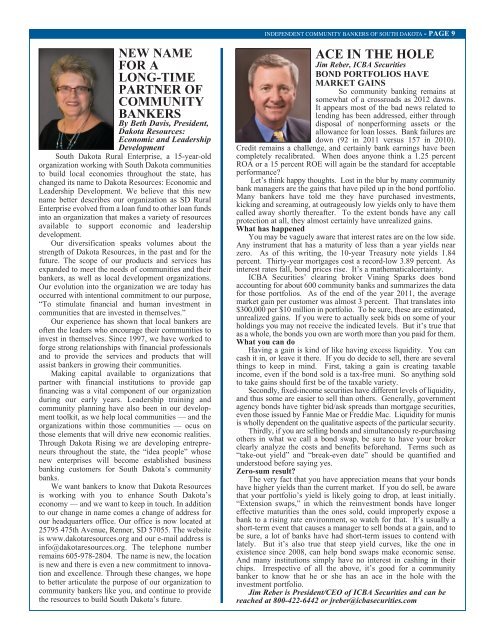Picture - ICBSD
Picture - ICBSD
Picture - ICBSD
You also want an ePaper? Increase the reach of your titles
YUMPU automatically turns print PDFs into web optimized ePapers that Google loves.
INDEPENDENT COMMUNITY BANKERS OF SOUTH DAKOTA - PAGE 9NEW NAMEFOR ALONG-TIMEPARTNER OFCOMMUNITYBANKERSBy Beth Davis, President,Dakota Resources:Economic and LeadershipDevelopmentSouth Dakota Rural Enterprise, a 15-year-oldorganization working with South Dakota communitiesto build local economies throughout the state, haschanged its name to Dakota Resources: Economic andLeadership Development. We believe that this newname better describes our organization as SD RuralEnterprise evolved from a loan fund to other loan fundsinto an organization that makes a variety of resourcesavailable to support economic and leadershipdevelopment.Our diversification speaks volumes about thestrength of Dakota Resources, in the past and for thefuture. The scope of our products and services hasexpanded to meet the needs of communities and theirbankers, as well as local development organizations.Our evolution into the organization we are today hasoccurred with intentional commitment to our purpose,“To stimulate financial and human investment incommunities that are invested in themselves.”Our experience has shown that local bankers areoften the leaders who encourage their communities toinvest in themselves. Since 1997, we have worked toforge strong relationships with financial professionalsand to provide the services and products that willassist bankers in growing their communities.Making capital available to organizations thatpartner with financial institutions to provide gapfinancing was a vital component of our organizationduring our early years. Leadership training andcommunity planning have also been in our developmenttoolkit, as we help local communities — and theorganizations within those communities — ocus onthose elements that will drive new economic realities.Through Dakota Rising we are developing entrepreneursthroughout the state, the “idea people” whosenew enterprises will become established businessbanking customers for South Dakota’s communitybanks.We want bankers to know that Dakota Resourcesis working with you to enhance South Dakota’seconomy — and we want to keep in touch. In additionto our change in name comes a change of address forour headquarters office. Our office is now located at25795 475th Avenue, Renner, SD 57055. The websiteis www.dakotaresources.org and our e-mail address isinfo@dakotaresources.org. The telephone numberremains 605-978-2804. The name is new, the locationis new and there is even a new commitment to innovationand excellence. Through these changes, we hopeto better articulate the purpose of our organization tocommunity bankers like you, and continue to providethe resources to build South Dakota’s future.ACE IN THE HOLEJim Reber, ICBA SecuritiesBOND PORTFOLIOS HAVEMARKET GAINSSo community banking remains atsomewhat of a crossroads as 2012 dawns.It appears most of the bad news related tolending has been addressed, either throughdisposal of nonperforming assets or theallowance for loan losses. Bank failures aredown (92 in 2011 versus 157 in 2010).Credit remains a challenge, and certainly bank earnings have beencompletely recalibrated. When does anyone think a 1.25 percentROA or a 15 percent ROE will again be the standard for acceptableperformance?Let’s think happy thoughts. Lost in the blur by many communitybank managers are the gains that have piled up in the bond portfolio.Many bankers have told me they have purchased investments,kicking and screaming, at outrageously low yields only to have themcalled away shortly thereafter. To the extent bonds have any callprotection at all, they almost certainly have unrealized gains.What has happenedYou may be vaguely aware that interest rates are on the low side.Any instrument that has a maturity of less than a year yields nearzero. As of this writing, the 10-year Treasury note yields 1.84percent. Thirty-year mortgages cost a record-low 3.89 percent. Asinterest rates fall, bond prices rise. It’s a mathematicalcertainty.ICBA Securities’ clearing broker Vining Sparks does bondaccounting for about 600 community banks and summarizes the datafor those portfolios. As of the end of the year 2011, the averagemarket gain per customer was almost 3 percent. That translates into$300,000 per $10 million in portfolio. To be sure, these are estimated,unrealized gains. If you were to actually seek bids on some of yourholdings you may not receive the indicated levels. But it’s true thatas a whole, the bonds you own are worth more than you paid for them.What you can doHaving a gain is kind of like having excess liquidity. You cancash it in, or leave it there. If you do decide to sell, there are severalthings to keep in mind. First, taking a gain is creating taxableincome, even if the bond sold is a tax-free muni. So anything soldto take gains should first be of the taxable variety.Secondly, fixed-income securities have different levels of liquidity,and thus some are easier to sell than others. Generally, governmentagency bonds have tighter bid/ask spreads than mortgage securities,even those issued by Fannie Mae or Freddie Mac. Liquidity for munisis wholly dependent on the qualitative aspects of the particular security.Thirdly, if you are selling bonds and simultaneously re-purchasingothers in what we call a bond swap, be sure to have your brokerclearly analyze the costs and benefits beforehand. Terms such as“take-out yield” and “break-even date” should be quantified andunderstood before saying yes.Zero-sum result?The very fact that you have appreciation means that your bondshave higher yields than the current market. If you do sell, be awarethat your portfolio’s yield is likely going to drop, at least initially.“Extension swaps,” in which the reinvestment bonds have longereffective maturities than the ones sold, could improperly expose abank to a rising rate environment, so watch for that. It’s usually ashort-term event that causes a manager to sell bonds at a gain, and tobe sure, a lot of banks have had short-term issues to contend withlately. But it’s also true that steep yield curves, like the one inexistence since 2008, can help bond swaps make economic sense.And many institutions simply have no interest in cashing in theirchips. Irrespective of all the above, it’s good for a communitybanker to know that he or she has an ace in the hole with theinvestment portfolio.Jim Reber is President/CEO of ICBA Securities and can bereached at 800-422-6442 or jreber@icbasecurities.com



